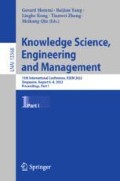Abstract
Identifying and classifying original discourse components is a prerequisite task for constructing the knowledge graph structure. Previous work suffers from the following problems. (i) Existing methods only rely on the discourse components themselves to extract the features of the text, and do not fully take into account the potential help of the context information of the discourse to consummate its own features. (ii) Most of the current methods usually combine multiple tasks for joint inference, with complementary effects among them, lacking methods focusing on the single-target task of discourse component recognition. To address these issues, we propose a graph neural network-based discourse component recognition model (DCRGNN), which enhances the interaction of sentence-level discourse component features through graph structure. Our experimental results show that DCRGNN achieves a relative improvement of up to 6% on Macro-F1 for specific discourse component types compared to the previous state-of-the-art methods on the Chinese dataset, and exceeds the baseline model in the single-target task on the English dataset.
Access this chapter
Tax calculation will be finalised at checkout
Purchases are for personal use only
References
Afantenos, S., Peldszus, A., Stede, M.: Comparing decoding mechanisms for parsing argumentative structures. Argument Comput. 9(3), 177–192 (2018)
Bao, J., Fan, C., Wu, J., Dang, Y., Du, J., Xu, R.: A neural transition-based model for argumentation mining. In: Proceedings of the 59th Annual Meeting of the Association for Computational Linguistics and the 11th International Joint Conference on Natural Language Processing (Volume 1: Long Papers), pp. 6354–6364 (2021)
Chakrabarty, T., Hidey, C., Muresan, S., McKeown, K., Hwang, A.: Ampersand: Argument mining for persuasive online discussions (2020)
Daxenberger, J., Eger, S., Habernal, I., Stab, C., Gurevych, I.: What is the essence of a claim? cross-domain claim identification, pp. 2055–2066 (2017)
Eger, S., Daxenberger, J., Gurevych, I.: Neural end-to-end learning for computational argumentation mining, pp. 11–22 (2017)
Gehring, J., Auli, M., Grangier, D., Dauphin, Y.N.: A convolutional encoder model for neural machine translation. arXiv preprint arXiv:1611.02344 (2016)
Hamilton, W., Ying, Z., Leskovec, J.: Inductive representation learning on large graphs. In: Advances in Neural Information Processing Systems, vol. 30 (2017)
Hasanzadeh, A., et al.: Bayesian graph neural networks with adaptive connection sampling. In: International Conference on Machine Learning, pp. 4094–4104. PMLR (2020)
He, K., Zhang, X., Ren, S., Sun, J.: Spatial pyramid pooling in deep convolutional networks for visual recognition. IEEE Trans. Pattern Anal. Mach. Intell. 37(9), 1904–1916 (2015)
Lawrence, J., Reed, C.: Argument mining: a survey. Comput. Linguist. 45(4), 765–818 (2020)
Levy, R., Bilu, Y., Hershcovich, D., Aharoni, E., Slonim, N.: Context dependent claim detection. In: Proceedings of COLING 2014, the 25th International Conference on Computational Linguistics: Technical Papers, pp. 1489–1500 (2014)
Niculae, V., Park, J., Cardie, C.: Argument mining with structured SVMs and RNNs (2017)
Persing, I., Ng, V.: End-to-end argumentation mining in student essays. In: Proceedings of the 2016 Conference of the North American Chapter of the Association for Computational Linguistics: Human Language Technologies, pp. 1384–1394 (2016)
Potash, P., Romanov, A., Rumshisky, A.: Here’s my point: Joint pointer architecture for argument mining, pp. 1364–1373 (2017)
Rinott, R., Dankin, L., Alzate, C., Khapra, M.M., Aharoni, E., Slonim, N.: Show me your evidence-an automatic method for context dependent evidence detection. In: Proceedings of the 2015 Conference on empirical methods in natural language processing, pp. 440–450 (2015)
Song, W., Song, Z., Fu, R., Liu, L., Cheng, M., Liu, T.: Discourse self-attention for discourse element identification in argumentative student essays. In: Proceedings of the 2020 Conference on Empirical Methods in Natural Language Processing (EMNLP), pp. 2820–2830 (2020)
Song, Y., Heilman, M., Klebanov, B.B., Deane, P.: Applying argumentation schemes for essay scoring. In: Proceedings of the First Workshop on Argumentation Mining, pp. 69–78 (2014)
Stab, C., Gurevych, I.: Identifying argumentative discourse structures in persuasive essays. In: Proceedings of the 2014 Conference on Empirical Methods in Natural Language Processing (EMNLP), pp. 46–56 (2014)
Stab, C., Gurevych, I.: Parsing argumentation structures in persuasive essays. Comput. Linguist. 43(3), 619–659 (2017)
Sun, D., Huang, Z., Li, D., Ye, X., Wang, Y.: Improved partitioning graph embedding framework for small cluster. In: Qiu, H., Zhang, C., Fei, Z., Qiu, M., Kung, S.-Y. (eds.) KSEM 2021. LNCS (LNAI), vol. 12815, pp. 203–215. Springer, Cham (2021). https://doi.org/10.1007/978-3-030-82136-4_17
Wang, H., Huang, Z., Dou, Y., Hong, Y.: Argumentation mining on essays at multi scales. In: Proceedings of the 28th International Conference on Computational Linguistics, pp. 5480–5493 (2020)
Acknowledgements
This work is supported by the National Key R &D Program of China under Grants (No. 2018YFB0204300).
Author information
Authors and Affiliations
Corresponding author
Editor information
Editors and Affiliations
Rights and permissions
Copyright information
© 2022 The Author(s), under exclusive license to Springer Nature Switzerland AG
About this paper
Cite this paper
Wang, S., Zhang, Z., Dou, Y., Luo, J., Huang, Z. (2022). Discourse Component Recognition via Graph Neural Network in Chinese Student Argumentative Essays. In: Memmi, G., Yang, B., Kong, L., Zhang, T., Qiu, M. (eds) Knowledge Science, Engineering and Management. KSEM 2022. Lecture Notes in Computer Science(), vol 13368. Springer, Cham. https://doi.org/10.1007/978-3-031-10983-6_28
Download citation
DOI: https://doi.org/10.1007/978-3-031-10983-6_28
Published:
Publisher Name: Springer, Cham
Print ISBN: 978-3-031-10982-9
Online ISBN: 978-3-031-10983-6
eBook Packages: Computer ScienceComputer Science (R0)

